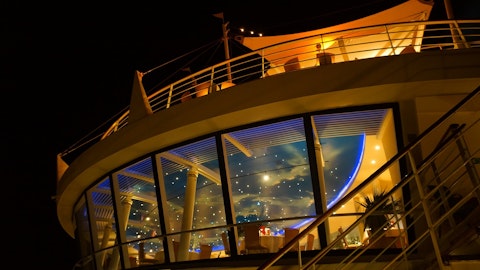Harry Sommer: And just to add to that, I know we talk a lot about metrics, NCC excluding fuel, or NCC excluding fuel and dry dock, but I want to emphasize that fuel expense is not something we ignore. Mark talked about it extensively in his prepared remarks. And our goal is to find ways to reduce consumption. Ultimately, obviously, that’s great for our sustainability goals, but it’s also great for our overall profitability. So I don’t want to — despite the fact that we don’t necessarily report on that metric extensively, I want to assure everyone that is one of the main focuses. I mean we spend something like $700 million a year on fuel, and Mark talked about the multi-, multi-, multi-million dollar things that we’re going to do to improve fuel from bunkering to better monitoring and things like that. And those numbers are real and of course, are reflected in our EBITDA numbers.
Vince Ciepiel: And then maybe one more for thinking about this kind of more normalized yield growth 2Q through 4Q. And maybe walk us through how you envision onboard versus ticket versus occupancy gains kind of contributing to that growth? And if it’s equal, if one is a bigger driver? Any additional color there would be helpful.
Mark Kempa: Yes. Look, onboard revenue is always a significant generator of our overall revenue profile. When you look at the quarters 2 through 4, yes, I think we’re getting probably, what, about 1.5 points of occupancy benefit in those 3 quarters, and the rest is really coming on the back of pricing. So on board is an important component, it always is, and it always has been. We’ll continue to improve on that. Our goal, again, is to get more of that wallet share well prior to the customer over stepping on foot any one of our vessels. And we continue to improve on that. And that — but I don’t think there’s going to — I don’t think we’re expecting any meaningful outsized growth from that particular revenue stream versus necessarily our core ticket price across the 3 brands.
Harry Sommer: Donna, I think we have time for one more question, please.
Operator: Our final question today is coming from Conor Cunningham of Melius Research.
Conor Cunningham: Maybe if I could just sneak two in. Just on the cost trajectory in 2024. Trying to understand a little bit more. I understand the dry docks and the inflation, but it’s — what’s the offset that’s happening there? Is marketing spend kind of trending down? And maybe secondly to stick with Mark on that as well. The comments around the balance sheet improvement, the tone is definitely changing. So that’s positive. Simple maths as you’re going to 6x leverage. Are we going to get back to this 3x to 4x that you did pre-COVID? Just any thoughts there would be helpful.
Harry Sommer: Yes. So I’ll let Mark talk about our balance sheet number because we’re very proud of that. And I’ll let him finish up the commentary on that. But on the cost side, this isn’t specifically related to marketing. We obviously will look at improvements in efficiencies and marketing in the same way we look at efficiencies everywhere else. But any improvement we find in marketing will be strictly around efficiency, the volume, if you will, of marketing will remain the same. We’re very happy with the demand we drive. We carefully track it through web visits, lead generation and all the other type of metrics that are necessary in order to keep both top and mid-funnel our marketing alive and well, and that volume will continue.
Any benefit we have will be on efficiency, not on volume. But really, the cost is everywhere. I mean, we talked about fuel, we talked about food waste. But I mean we could go through every line item of the P&L. There is nothing off the table. I mean we’ve made improvements in air costs. We made improvements in our consumables and maintenance, really across the way in SG&A expenses. So I really want you to think about it as a whole P&L and not that we’re going to, in any way, focus on marketing in order to reduce those important demand metrics. And Mark take it away.
Mark Kempa: Conor on leverage. Look, we’ve said we are very focused on it. And we’ve said that this will improve significantly over time. We’re very excited that we expect our leverage — current leverage levels at year-end. We expect to at least decrease that by 1.5 turns. And again, that’s going to — that’s slowly but surely restoring our balance sheet back to pre-COVID levels. So obviously, that 3% to 4% range is something we’re focused on. I would not — certainly would not expect that to happen in 2024, but we are starting the sequential improvement quarter after quarter. This year, you will see significant improvements in leverage. And we’re excited to see that same thing happening over the course of ’25 and ’26. So we’re on the right path.
Harry Sommer: The only thing I’ll add to Mark’s comment is just a simple math one. If we were at 7.3%, and we plan to reduce it by 1.5%, I think the number would be in the 5-something range, not the 6-something range just to keep that in the back of your mind. That being said, I want to thank everyone for joining us today. We’ll be around to answer any questions you may have. We look forward to seeing you all in May. We wish you a great day and all the best.
Operator: Ladies and gentlemen, this concludes today’s conference. You may disconnect your lines and log off the webcast at this time, and enjoy the rest of your day.





